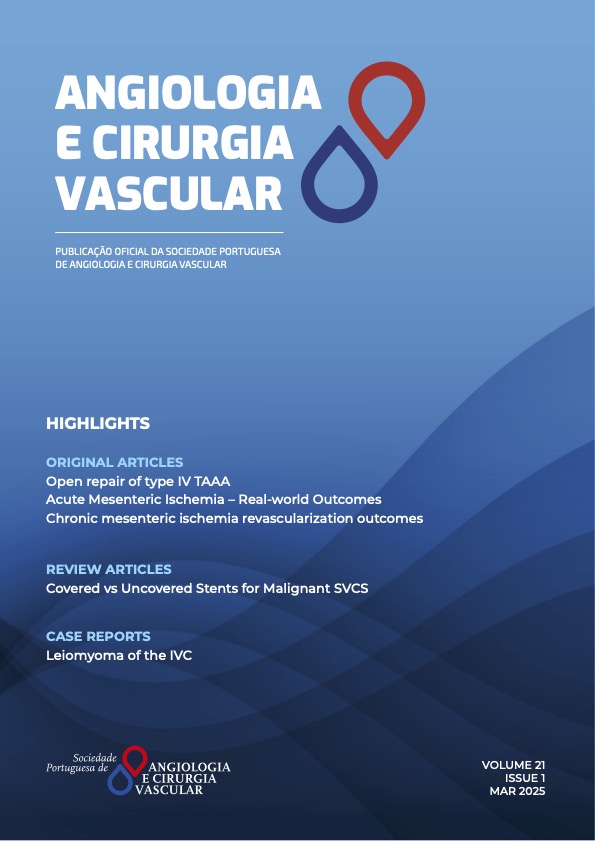The challenging management of acute mesenteric ischemia - too frail or too late?
DOI:
https://doi.org/10.48750/acv.605Palavras-chave:
Acute mesenteric ischemia, mortality, prognostic factorsResumo
INTRODUCTION: acute mesenteric ischemia (AMI) presents a life-threatening emergency, requiring a high degree of suspicion for timely diagnosis. Despite advancements in the management of these patients, in-hospital mortality rates remain high. This study aims to assess the outcomes and prognostic factors in patients with AMI.METHODS: A retrospective single-center analysis of all patients undergoing emergent surgery for arterial occlusive AMI between January 2020 and February 2024 was conducted. The primary outcome was 30-day survival. Correlations between survival and laboratory biomarkers at admission were investigated.
RESULTS: Thirty patients underwent emergent surgery for occlusive AMI. The overall 30-day survival rate was 33%. Pre-operative arterial HCO3-to-lactate ratio ≤ 10 and neutrophil-to-lymphocyte ratio > 16 correlated with lower survival, showing 83% and 59% sensitivities, respectively, and 100% specificity for 30-day mortality.
CONCLUSION: Despite advancements in patient management strategies, AMI mortality rates remain high. The neutrophil-to-lymphocyte ratio has been proposed as a diagnostic and prognostic marker in AMI. While the HCO3-to-lactate ratio has not yet been described, it may serve as a more sensitive and specific predictor of mortality than lactate alone.
Downloads
Referências
Klar E, Rahmanian PB, Bücker A, Hauenstein K, Jauch KW, Luther B. Acute mesenteric ischemia: a vascular emergency. Disch Aztebell Int. 2012;092:49-56.
Khan A, Hese L, Mathur S, Civill. Damage-control laparotomy in nontrauma patients: review of indications and outcomes. J Trauma Acute Care Surg 2013;75:365-8.
Acosta S, Ogren M, Sternby NH, Bergqvist D, Björck M. Clinical implications for the management of acute thromboembolic occlusion of the superior mesenteric artery: autopsy findings in 213 patients. Ann Surg 2005;241:516-22.
Kärkkäinen JM, Lehtimäki TT, Manninen H, Paajanen H. Acute Mesenteric Ischemia is a More Common Cause than Expected of Acute Abdomen in the Elderly. Gastrointest Surg: 2015;191:407-14.
Cokkinis AJ. Mesenteric vascular occlusion. B J Surg 2006;14:543.
Adaba F, Askari A, Dastur J, Patel A, Gabe SM, Vaizey CJ, et al. Mortality after acute primary mesenteric infarction: a systematic review and meta-analysis of observational studies. Colorectal Dis 2015;7:566-77.
Sumbal R, Ali Baig MM, Sumbal A. Predictors of Mortality in Acute Mesenteric Ischemia: A Systematic Review and Meta-Analysis. J Surg Res. 2022;275:72-86.
Studer P, Vaucher A, Candinas D, Schindiger B. The value of serial serum lactate measurements in predicting the extent of ischemic bowel and outcome of patients suffering acute mesenteric ischemia. J. Gastrointest. Surg. 2015;197:51-5.
Björck M, Koelenway M, Acosta S, Bastos Goncalves F, Köibel T, Kolkman JJ, et al. Editor’s Choice - Management of the Diseases of Mesenteric Arteries and Veins: Clinical Practice Guidelines of the European Society of Vascular Surgery (ESVS). Eur J Vasc Endovasc Surg. 2017;53:460-510.
Ozturk S, Unver M, Ozdemir M, Bozbivik O, Turk Y, Frat O, et al. Prognostic factors in acute mesenteric ischemia and evaluation with multiple logistic regression analysis effecting morbidity and mortality. Pol Przegl Chir 2020;35:25-33.
Wang S, Liu H, Wang Q, Cheng Z, Sun S, Zhang Y, et al. Neutrophil-to-Lymphocyte Ratio and Platelet-to-Lymphocyte Ratio Are Effective Predictors of Prognosis in Patients with Acute Mesenteric Arterial Embolism and Thrombosis. Ann Vasc Surg. 2018;49:115-22.
Gunst J, Kashani KB, Hermans G. The urea-creatinine ratio as a novel biomarker of critical illness-associated catabolism. Intensive Care Med. 2019;45:1813-5.
Kärkkäinen JM, Acosta S. Acute mesenteric ischemia (part I) - Incidence, etiologies, and how to improve early diagnosis. Best Pract Res Clin Gastroenterol. 2017;31:15-25.
Block TA, Acosta S, Björck M. Endovascular and open surgery for acute occlusion of the superior mesenteric artery. J Vasc Surg. 2010;52:959-66.
Kühn F, Schiergens TS, Klar E. Acute Mesenteric ischemia. Visc Med. 2020;36:256-62.
Luther B, Moussazadeh K, Müller BT, Franke C, Harms JM, Ernst S, et al. The acute mesenteric ischemia - not understood or incurable? Zbl Chir 2002;127:674-84.
Achanti A, Szerlip HM. Acid-Base Disorders in the Critically Ill Patient. Cl J Am Soc Nephrol. 2023;810:2-12.
Nguyen Tat T, Vo Hoang-Thien N, Nguyen Tat D, Nguyen PH, Ho LT, Doan DH, et al. Prognostic values of serum lactate-to-bicarbonate ratio and lactate for predicting 28-day in-hospital mortality in children with dengue shock syndrome. Medicine. 2024;103:e36000.
Coelho NH, Coelho A, Augusto R, Semião C, Peixoto J, Fernandes L, et al. Pre-operative Neutrophil to Lymphocyte Ratio is Associated With 30 Day Death or Amputation After Revascularisation for Acute Limb Ischaemia. Eur J Vasc Endovasc Surg 2021;627:4-80.
Bhat TM, Afari ME, Garcia LA. Neutrophil lymphocyte ratio in peripheral vascular disease: a review. Expert Rev. Cardiovasc. Ther. 2016;14:871-S.
Taurino M, Aloisi F, Del Porto F, Nespola M, Dezi T, Pranteda C, et al. Neutrophil-to-Lymphocyte Ratio Could Predict Outcome in Patients Presenting with Acute Limb Ischemia. J Clin Med. 2021;10:4343.
Su Mi, Liu CW. Neutrophil-to-Lymphocyte ratio associated with an increased risk of mortality in patients with critical limb ischemia. PloS one. 2021;16:e0252030.
Uchino S, Bellomo R, Goldsmith D. The meaning of the blood urea nitrogen/creatinine ratio in acute kidney injury. Clin Kidney J. 2012;5187-91.








